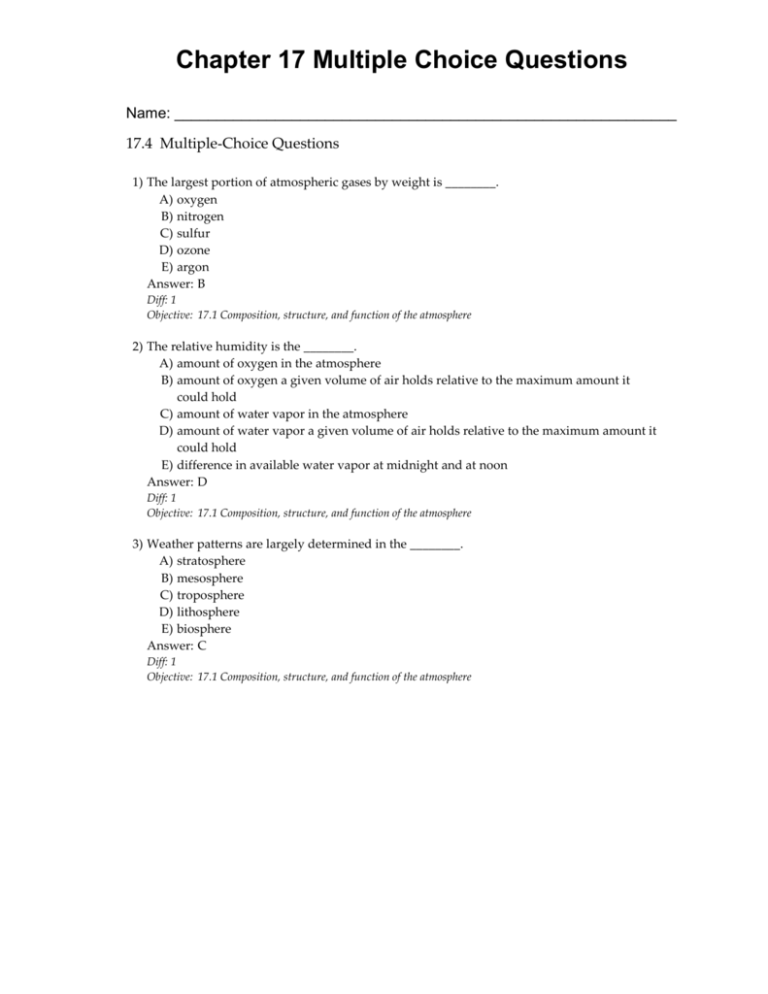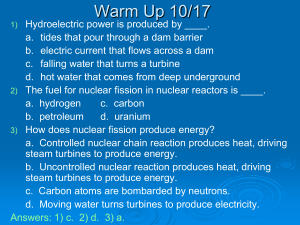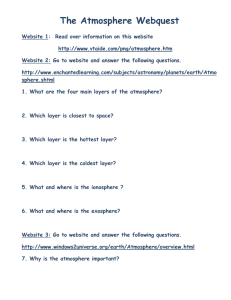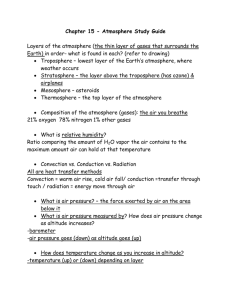Chapter 17 Multiple Choice Questions (Answers). - science-b
advertisement

Chapter 17 Multiple Choice Questions Name: ____________________________________________________________ 17.4 Multiple-Choice Questions 1) The largest portion of atmospheric gases by weight is ________. A) oxygen B) nitrogen C) sulfur D) ozone E) argon Answer: B Diff: 1 Objective: 17.1 Composition, structure, and function of the atmosphere 2) The relative humidity is the ________. A) amount of oxygen in the atmosphere B) amount of oxygen a given volume of air holds relative to the maximum amount it could hold C) amount of water vapor in the atmosphere D) amount of water vapor a given volume of air holds relative to the maximum amount it could hold E) difference in available water vapor at midnight and at noon Answer: D Diff: 1 Objective: 17.1 Composition, structure, and function of the atmosphere 3) Weather patterns are largely determined in the ________. A) stratosphere B) mesosphere C) troposphere D) lithosphere E) biosphere Answer: C Diff: 1 Objective: 17.1 Composition, structure, and function of the atmosphere 4) Seasons are a result of ________. A) Earth rotating near the sun, then farther away B) differences in the amount and intensity of sunlight brought about by the tilt of the axis C) alterations in Hadley cells D) changes in day length E) the phases of the moon Answer: B Diff: 2 Objective: 17.1 Composition, structure, and function of the atmosphere 5) Near the equator, the patterns of convection currents are called ________. A) Coriolis cells B) Hadley cells C) high-pressure cells D) El Niño events E) the troposphere Answer: B Diff: 1 Objective: 17.1 Composition, structure, and function of the atmosphere 6) Natural sources of air pollution come from ________. A) internal combustion engines B) coal-fired electrical plants C) salt from sea spray, cattle, soil dust, volvanic dust D) evaloration of solvents E) birds Answer: C Diff: 2 Objective: 17.2 Outdoor air pollution; potential solutions 7) The dust storms that have large impacts on the Caribbean ________. A) provide nutrients and improve the water quality for the coral reef systems B) are the result of polar cells C) are the result of poor farming techniques D) are the result of glacier melt E) are the result of ozone depletion Answer: C Diff: 2 Objective: 17.2 Outdoor air pollution; potential solutions 8) Carbon monoxide is ________. A) caused by ozone depletion B) a major component of the atmosphere C) extremely damaging to human blood D) produced by plants during photosynthesis E) consumed by plants for photosynthesis Answer: C Diff: 2 Objective: 17.2 Outdoor air pollution; potential solutions 9) Tropospheric ozone ________. A) protects Earth from most of the harmful UV radiation B) binds with hemoglobin, preventing binding with oxygen in red blood cells C) is produced through the interaction of heat and light, with nitrogen oxides and other carbon-containing compounds D) is a primary pollutant E) is caused by poor farming techniques Answer: C Diff: 1 Objective: 17.2 Outdoor air pollution; potential solutions 10) Lead enters the atmosphere as a particulate pollutant. This is a problem because it ________. A) is a precious metal, and it is being lost to the atmosphere B) will cause the ozone hole to increase C) causes central nervous system malfunction in humans D) can become attached to radon E) causes excess nutrification of waterways, resulting in eutrophication Answer: C Diff: 1 Objective: 17.2 Outdoor air pollution; potential solutions 11) Radon ________. A) is caused by the breakdown of the ozone layer B) may cause damage to respiratory tissues when inhaled C) binds with hemoglobin, preventing binding with oxygen D) contributes to the breakdown of the ozone layer E) in the atmosphere limits the availability of sunlight for plants Answer: B Diff: 2 Objective: 17.2 Outdoor air pollution; potential solutions 12) Photochemical smog differs from industrial smog in that it ________. A) is formed in the presence of sunlight B) has large quantities of soot C) is primarily composed of carbon monoxide D) consists of primary pollutants E) is an unhealthy mixture of pollutants Answer: A Diff: 1 Objective: 17.2 Outdoor air pollution; potential solutions 13) One of the problems that occurs as a consequence of CFC pollution is ________. A) increasing skin cancer in humans B) toxins accumulating in homes C) damage to human red blood cells D) movement of toxins into lakes and rivers, which poisons fish E) eutrophication Answer: A Diff: 1 Objective: 17.2 Outdoor air pollution; potential solutions 14) A great deal of indoor air pollution comes from ________. A) outdoor pollution B) carbon monoxide C) cooking D) carpets and furniture E) washing dishes Answer: D Diff: 2 Objective: 17.5 Indoor air pollution; potential solutions 15) In developed countries, the two most deadly sources of indoor pollution are ________. A) pesticides and cleaning agents B) synthetic furniture materials and radiation from electronic equipment C) radiation from electronic equipment and pesticides D) radon and cigarette smoke E) pesticides and cigarette smoke Answer: D Diff: 1 Objective: 17.5 Indoor air pollution; potential solutions 16) Bacteria and fungal spores can be included as ________. A) contributors to indoor pollutants B) VOCs and POPs C) sources of radon in the home D) problems in degrading the ozone layer E) the cause of high pesticide use in the home Answer: A Diff: 1 Objective: 17.5 Indoor air pollution; potential solutions 17) Particulate matter dispersed as aerosols ________. A) includes nitrogen oxides B) may cause damage to respiratory tissues when inhaled C) binds with hemoglobin, preventing hemoglobin's binding with oxygen D) interacts only with surface tissues of humans, causing mild irritation E) is problematic because it decreases primary productivity by limiting the availability of sunlight for plants Answer: B Diff: 2 Objective: 17.5 Indoor air pollution; potential solutions 18) Acidic deposition ________. A) causes ozone depletion B) is a major component of indoor air pollution C) causes eutrophication in streams and rivers D) often crosses national boundaries, creating international disputes E) is primarily a local problem near point sources Answer: D Diff: 2 Objective: 17.4 Acidic deposition and its consequences 19) Which of the following is a consequence of acidic deposition? A) It increases the likelihood of low-lying ground fogs. B) It results in offshore eutrophication, damaging coral reefs. C) It creates rainwater that can damage skin cells or cause cancers. D) It changes soil chemistry, leaching out important minerals. E) It is increasing the rate of global warming. Answer: D Diff: 2 Objective: 17.4 Acidic deposition and its consequences 20) The Coriolis effect ________. A) keeps Earth from spinning too fast B) is caused by the moon C) results in ice and dark at the poles in winter D) keeps the wind circulating at constant speed around the planet E) is caused by earth's rotational forces Answer: E Diff: 1 Objective: 17.1 Composition, structure, and function of the atmosphere 21) The Coriolis effect contributes to ________. A) global wind patterns B) global warming C) increased acidic deposition D) a reduction in eutrophication E) an increase in eutrophication Answer: A Diff: 1 Objective: 17.1 Composition, structure, and function of the atmosphere 22) The long-term health effects of indoor air pollution ________. A) is considered to be a minor hazard compared to outdoor air pollution B) are not well understood; studies are under way C) has only a few causes, which can easily be remedied D) is primarily caused by CFCs E) is one of the causes of the increase in skin cancer in the United States Answer: B Diff: 1 Objective: 17.5 Indoor air pollution; potential solutions 23) Air near Earth's surface tends to be ________. A) warmer and wetter; then it rises, expanding and cooling B) warmer and drier; then it rises, condensing and gathering moisture C) cooler and wetter; then it rises, is warmed by the sun, and sinks again D) cooler and drier; it rises when it is displaced by sinking warm air E) warmer; it rises as it is displaced by Coriolis forces Answer: A Diff: 1 Objective: 17.1 Composition, structure, and function of the atmosphere 24) The most obvious cause of industrial smog is ________. A) burning trash B) fires for heating food C) indoor air pollution D) burning fossil fuels E) generation of nuclear power Answer: D Diff: 1 Objective: 17.2 Outdoor air pollution; potential solutions 25) You have been hired by a rapidly growing small city to improve the air quality, which has deteriorated in the past 10 years. Your first suggestion is to ________. A) try to negotiate with the large city downwind whose factories produce large amounts of pollution B) decrease the amount of CFCs used locally C) move or close the cattle feed lots near the river D) improve transportation options, including carpool lanes, buses, and light rail E) remove the hydroelectric dam on the river Answer: D Diff: 2 Objective: 17.2 Outdoor air pollution; potential solutions 26) London has instituted what some drivers feel is a draconian solution to vehicular air pollution, but one which has the attention of many other large cities: ________. A) banning vehicles which are fuel-inefficient B) impounding cars and fining drivers who are heavy polluters C) raising by 5 times bridge and expressway tolls D) charging fuel-inefficient or polluting vehicles a fee to drive in the city E) publishing photos of arrested polluters in the London Times Answer: D Diff: 2 Objective: 17.2 Outdoor air pollution; potential solutions 27) The reason that temperature increases with altitude through most of the stratosphere is ________. A) heat released by absorption of UV radiation by oxygen and ozone B) sunlight is more intense in the stratosphere C) jet stream winds produce frictional heat D) water vapor levels are high and store heat E) greenhouse gases warm the air Answer: A Diff: 2 Objective: 17.1 Composition, structure, and function of the atmosphere






